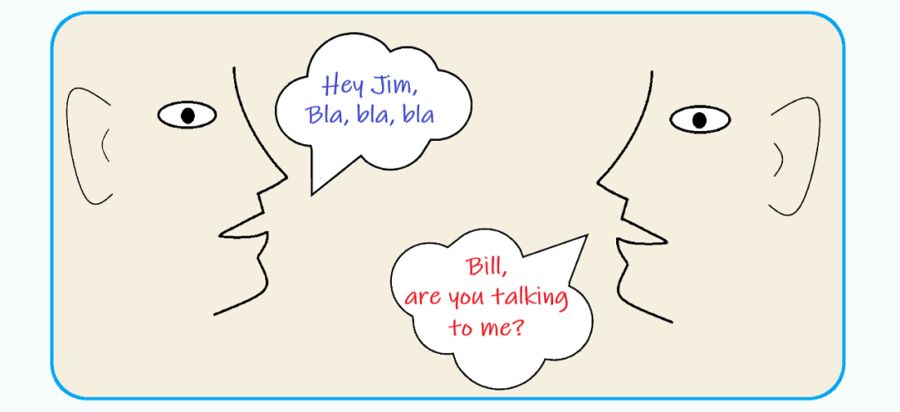Simplicity In Communicating –
Communicating is about the message a speaker (sender) transmits and the message a listener (receiver) understands. It is a verbal give and take between two or more people. I have written many articles and blogs devoted to communication. One such article is Five Roadblocks To Effective Communications. The focus of this blog is to strip the concept of communication down to its very simplest, basic form.
To demonstrate simplicity in communicating this will probably be one of my shortest in length blogs! If your goal is simplicity in communication, this blog will demonstrate simplicity!
- Simplicity
When talking with others, use “smaller”, less complex words. Is your goal of communication to come to an agreement or a resolution? If your goal is communication, use the smallest, simplest words possible. If someone has to try and understand what you are saying, they soon begin to focus on the meaning of the individual words, as opposed to the meaning of what you are saying or writing.
Alternate thought: If your general vocabulary includes 5 syllable words, and the people you generally speak with do the same, by all means continue to use your speech patterns. Just be aware not everyone speaks the way you do.
- Brevity
Use shorter sentences. If you can say something in 5 words instead of 12 words, do it! If you ramble on, and on, and on, and on, and on, and on, you will eventually lose the attention and focus of the other person. Don’t be unnecessarily wordy. Make your message just as long as it needs to be — then make it a little bit shorter.
Alternate thought: There are a number of successful communicators who are wordy. But this is a select group of people. If you are attempting to communicate with your mechanic, and you want your car fixed right, it is probably best to be brief and to the point! They are busy people!
- Credibility
If you want communication to occur, people need to believe you, and believe your message. This is called credibility. It doesn’t matter how beautiful your message is. If people don’t believe you, what you are saying is worthless.
Alternate thought: You can flood another person with 15 reasons why you are right, but it doesn’t make you credible.
- Memorable
For communication to be successful, it has to be memorable. People need to remember what you said. Your words have to mean something. You don’t have to give a great oration every time you communicate with someone, just that what you say is relevant and has meaning.
Alternate thought: Repetition isn’t always boring. Think about Martin Luther King’s “I have a dream” speech. That phrase was repeated frequently, and who doesn’t remember it?
- Novelty
Novelty is the uniqueness in messaging. Companies spend millions of dollars on advertising to create the novelty of their messaging. A plain old chicken sandwich becomes a “mouthwatering explosion of delectable flavor!”
Alternate thought: It is easy to lose your receiver / listener if you use jargon, for example, “BTW”. “BTW” is just a short version for “by the way”. If you want your listener to hear everything you are saying, don’t lose them with jargon, “BTW”.
- Sound and Texture
Fifty years after his passing, could you still identify the voice of John F. Kennedy saying, “Ask not what your country can do for you – ask what you can do for your country”? YouTube – HuntleyFilmArchives.com Voices have texture just like fabric. Imagine touching cool, smooth satin. Now imagine a voice that is clear and cool, yet slippery and swirling around you. Likewise, imagine touching a thick pile of velvet. The response is warm, deep, soft, so cushy and absolutely luxurious. You can melt in the luxury of the sound. Singers Heart Studio – Voice Texture
Alternate thought: Don’t be caught off guard by that “smooth talking” individual! Sometimes the quality of one’s voice is not consistent with honesty or telling the truth.
- Speak Inspirationally
When crafting words that work, you need to say what people want to hear. It is about reaching someone on a personal level. You will be letting them know that what you are offering can give them the lives they want. And make them the people they want to be.
Alternate thought: Inspiration is not about telling people what they want to hear as a form of deception (lying) or manipulation. It is about lifting people up or inspiring them.
- Visualize
People need to be able to see and feel what you’re telling them. Make an abstract thought more concrete by painting a clear picture. By using just one descriptive word, you can guide people to your thought process. For example, “wilted flower” brings up a different image than a “budding flower”.
Alternate thought: You can be too descriptive or too flowery in your description. Remember brevity (#2 above). People can get carried away with the imagery and forget your point!
- Ask Questions
Asking a simple, rhetorical, open ended question might be the most powerful form of messaging you can have. A question can cut to the heart of an issue and can force readers and listeners to engage.
Alternate thought: Sometimes it is important that you have a general idea of an answer before asking a question. That way you can plan ahead and be prepared!
- Provide Context and Explain Relevance
Your messaging, no matter how ingenious, doesn’t exist in a vacuum. You have to be mindful of how your messaging fits in to the broader context of the conversation. The Creator’s Path – Words That Work: The 10 Rules of Communication
Alternate thought: If the conversation is about a movie the two of you just watched and you bring up your favorite brownie recipe, you will lose your listener.
Conclusion
Use these simple ideas to increase communication.
With warmest regards,
To be notified of new posts like Simplicity In Communicating: Become Better Understood, please enter your email address and click on the Subscribe button.









